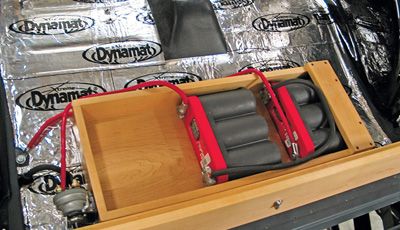
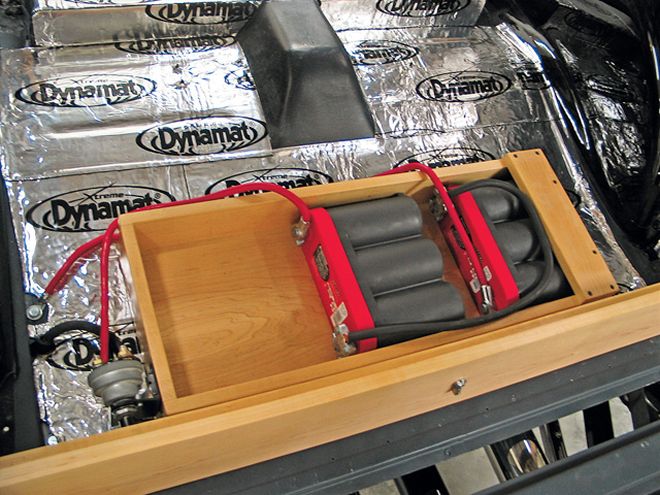
A lot of rodders look at 12-volt car batteries the way most non-enthusiasts look at engines. They don't know exactly what's happening on the inside, and they sure as heck couldn't build one, but they're happy as long as it keeps doing what it's supposed to. We can't show you how to build a battery, but we do have a few tips on how to keep yours doing what it does.
Your car battery is a lead-acid battery, called that because it is constructed of positively and negatively charged lead plates, soaking in a conductive electrolyte soup of sulfuric acid and water, commonly known as battery acid. This produces chemical energy, which is converted to electrical energy. When you turn the key, that electricity provides the current for firing the ignition system and accessories.
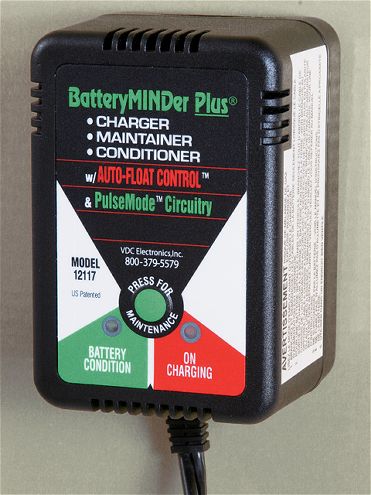 Optima may be the best-known manufacturer of AGM batteries. Unlike other AGMs, which use flat absorbent glass mats, Optima's distinctive design features mats rolled into six spirals. The company calls it Spiralcell Technology, and it's remarkably sturdy. Optima batteries feature different-colored tops; red is a good starting battery for general street use.
Optima may be the best-known manufacturer of AGM batteries. Unlike other AGMs, which use flat absorbent glass mats, Optima's distinctive design features mats rolled into six spirals. The company calls it Spiralcell Technology, and it's remarkably sturdy. Optima batteries feature different-colored tops; red is a good starting battery for general street use.
Other important components to keep the battery running are the alternator and the voltage regulator. We discussed those in the April issue of R&C. Right now, we're focusing on batteries and chargers to understand some of the technology out there, how it's changed, and how it can keep you happy.
Battery Tech
All lead-acid car batteries perform the same function using the same basic science, but there have been some design improvements in the last several years.
A flooded battery is the type you've had in your cars since you were a kid. Caps on the battery top allow you to check the levels of the liquid electrolyte in the various cells, adding more if any evaporates. They weigh as much as an anvil, require regular maintenance and careful handling, are subject to hazardous leaking or spillage, and must be mounted upright in vibration-free areas where they won't pose a danger.
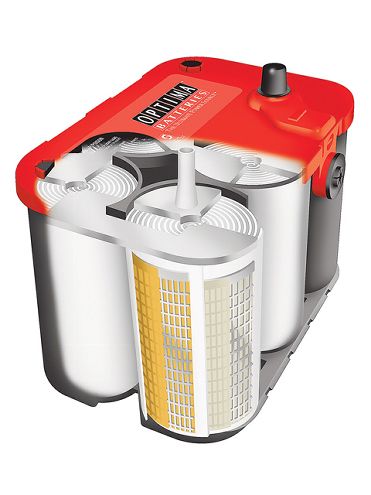
Gel batteries were developed in an effort to reduce the hassle of liquid-filled flooded batteries. Manufacturers added silica to the electrolyte to congeal it. The gelatinous electrolyte content in these batteries greatly reduces the chance of spilling or evaporation and is less vulnerable to vibration.
AGM (absorbent glass mat) style batteries are relatively new compared to flooded batteries but have been around long enough to become the battery of choice for many enthusiasts for a number of reasons. Two well-known brand names are Optima and Odyssey, although a minute on the Internet will reveal that many companies now offer AGM batteries. They are referred to as "dry cell," "sealed," or "maintenance-free" batteries and sometimes, incorrectly, as "gel" batteries. In AGM batteries, the entire electrolyte is suspended in absorbent fiberglass mats (now you know where the name comes from), which separate the lead plates.
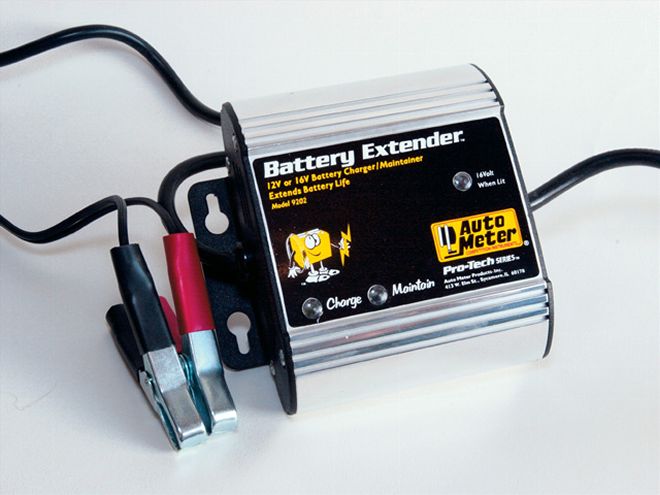 The Auto Meter Battery Extender comes in a 12-volt version as well as a 12-/16-volt version, both of which provide electronically controlled charging for flooded, gel, and AGM batteries. The Battery Extender maintains a proper charge during storage and is not meant for in-use batteries. The LED light indicates a highly sulfated battery or bad cell.
The Auto Meter Battery Extender comes in a 12-volt version as well as a 12-/16-volt version, both of which provide electronically controlled charging for flooded, gel, and AGM batteries. The Battery Extender maintains a proper charge during storage and is not meant for in-use batteries. The LED light indicates a highly sulfated battery or bad cell.
A huge technical advantage of AGM batteries is the fact that they are maintenance-free. Since the electrolyte is immobilized and the batteries are completely sealed, there is no danger of leakage, spilling, or evaporation. This eliminates the need for occasional water fill-ups. They also typically provide higher cranking amps than flooded-type batteries, but with lower self-discharge.
Mounting Concerns
We asked battery manufacturers about the pros and cons of various mounting options. The construction of AGM batteries makes them much more vibration-resistant than flooded-type batteries, and the smaller overall dimensions make them lighter and easier to mount in tight spaces. All of this means far more mounting choices. Some of the manufacturers we talked to discouraged mounting any battery, even AGM batteries, in the interior of a vehicle, although others reported that customers had successfully mounted their AGM batteries under seats and dashes, in glove compartments, and behind kick panels. Practically all manufacturers discouraged mounting it upside down, and we couldn't think of a good reason why you would. Wherever the battery ends up, it should be in a spot where the terminals will not come in contact with any obstacles, especially metal parts that could short out against the terminals.
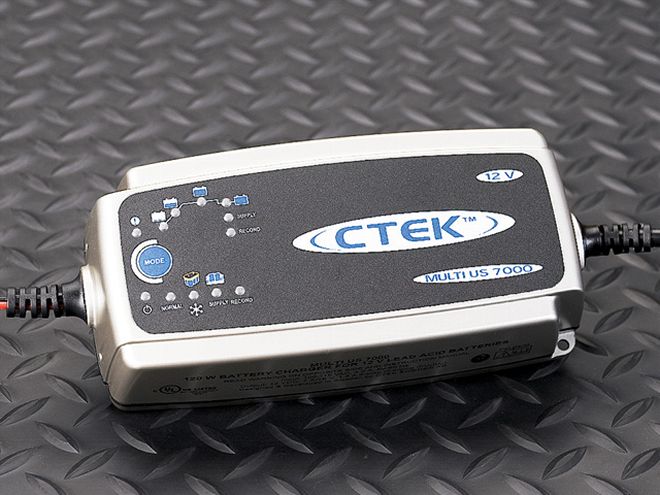 The 7-amp CTEK Power US 7000 will charge, maintain, and recondition a drained battery and can be used for out-of or in-car charging without loss of power of electronic memory functions. The Multi US 3300 is a 3.3-amp version that can recharge a battery within an hour.
The 7-amp CTEK Power US 7000 will charge, maintain, and recondition a drained battery and can be used for out-of or in-car charging without loss of power of electronic memory functions. The Multi US 3300 is a 3.3-amp version that can recharge a battery within an hour.
For hot rodders, the trunk is a safe and convenient location, but hot rodders commonly make the mistake of not running an adequate-sized cable from the trunk to the engine compartment.
When running a long cable, remember to upsize it in order to avoid a voltage drop that would handicap the battery, and possibly prevent the car from starting. Scottie Johnson at Powermaster Performance, which makes AGM batteries for race and street applications, hears about this from a lot of customers. He told us six-gauge wire may be fine for carrying power a few feet from the battery to the starter, but stretching it out from the trunk to the engine compartment will increase resistance in the cable, causing a voltage drop. He recommends a minimum of four-gauge wire, and even as large as two- or zero-gauge for remotely mounted batteries.
He also suggests putting a fuse near the rear-mounted battery. In the event of an accident, if the wire gets pinched between the battery and the starter, it could short out the cable, possibly causing a fire. An adequate fuse-he recommends 250 to 300 amp-should be sufficient insurance to keep it from blowing when starting the car.
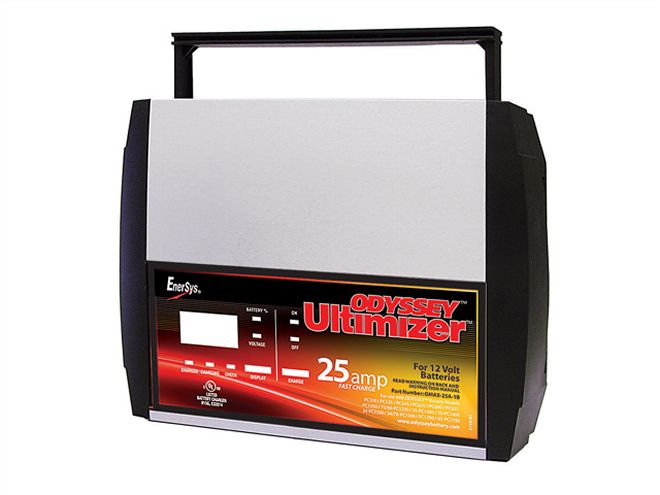 The Odyssey Ultimizer charger is designed specifically for use with Odyssey AGM batteries, charging the battery to 14.7 volts and maintaining a float charge of 13.6 volts. The Ultimizer line include six chargers, ranging from 6 to 50 amps.
The Odyssey Ultimizer charger is designed specifically for use with Odyssey AGM batteries, charging the battery to 14.7 volts and maintaining a float charge of 13.6 volts. The Ultimizer line include six chargers, ranging from 6 to 50 amps.
Charging
As battery technology has changed, so have battery chargers. Like new batteries, new chargers are smaller, but they're also smarter than the old trickle charger that's been sitting under your workbench and that may no longer be the best for charging or maintaining an AGM battery.
Most old-style chargers are designed to deliver constant amperage to the battery. The user selects the proper amperage and what the charger will supply. As amperage is applied, voltage increases until the battery is recharged to around 14.5 volts. If the charge goes beyond that point on a flooded-type battery, the electrolyte may boil and water might evaporate, but that water can be replaced.
On a sealed AGM battery, the water cannot be replenished. The battery may be able to discharge, but every recharge will cause it to dry out further. That risk is eliminated with the new electronic chargers, which rely on a computer to continually monitor battery condition and other factors (like ambient temperature) to provide and maintain the correct charge. The chargers go through a series of modes during the charging process. The number of modes and how they're identified differs from manufacturer to manufacturer, but what happens in every case is the charger provides a constant current voltage. The amperage is reduced to complete the charge as the battery gets close to full charge, in the neighborhood of 14.5 volts. After that, the charger goes into float mode, maintaining the level of the charge indefinitely.
 In addition to a line of battery chargers, VDC Electronics offers the small BatteryMINDer PLUS charger/maintainer/conditioner for use with all 12-volt lead-acid batteries. In addition to charging, it eliminates failure-causing sulfation from the battery plates, and will not overcharge.
In addition to a line of battery chargers, VDC Electronics offers the small BatteryMINDer PLUS charger/maintainer/conditioner for use with all 12-volt lead-acid batteries. In addition to charging, it eliminates failure-causing sulfation from the battery plates, and will not overcharge.
An unused AGM battery is able to hold a charge longer than a flooded-type, but after time will discharge, causing sulfate to build up on the lead plates, shortening battery life. If you're storing batteries or have your hot rod in storage for an extended period of time, these new chargers are designed to remain connected to the battery, preventing sulfation without the risk of overcharging. Most of the products we looked at are small enough to be mounted anywhere in the car and remain attached to the battery to maintain the charge, preventing unwanted surprises on a cold morning or after a day parked at the show with the audio system going.
Speaking of overcharging, the best battery chargers, despite their small size, come with a big price tag. But, a quality charger is a good investment when you consider the money you save by extending the life of your battery.
Some of the chargers we looked into (the ones shown in these photos) can be used to charge flooded batteries as well as AGM types. These are just a small sample of the products on the market, so be sure to talk to the manufacturers and read the instructions before charging to make sure the charger and battery are compatible.